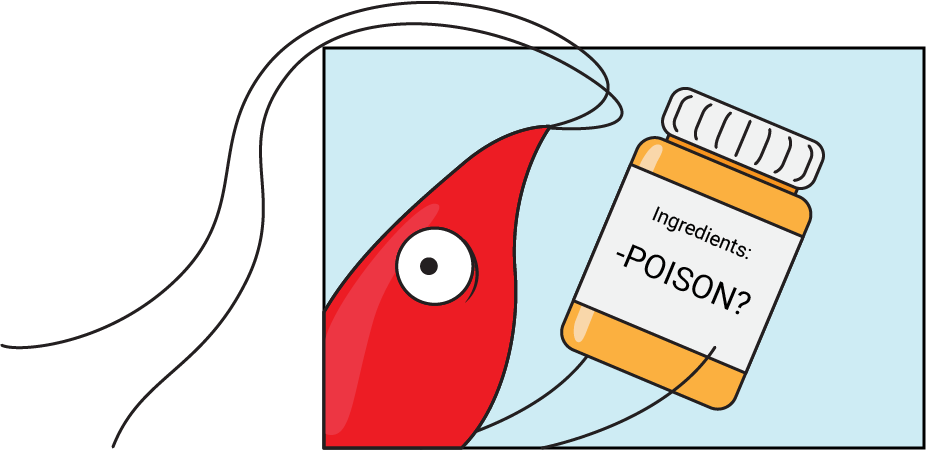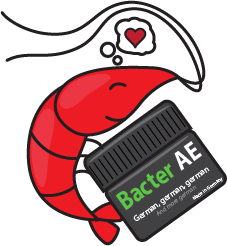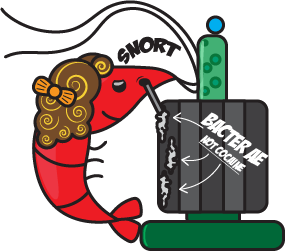Shrimply Explained is currently undergoing renovations. Please don't buy anything yet. Thank you!
After diving into the world of shrimp keeping, one of the first supplements you might hear about is Glasgarten Bacter AE. A LOT of shrimp keepers add this to their tank due to the claimed benefits of adding “important microorganisms, amino acids, and enzymes” that improve water quality and encourage biofilm growth. This is supposed to improve the diet of your shrimp and increase shrimplet survival rate. All that sounds great—but some users report ammonia spikes, low oxygen levels, and shrimp deaths after using Bacter AE.
So, are the benefits backed by anything or just clever marketing of an otherwise questionable powder?
Let's take a look at the ingredients to find out.

Please note that most of the research cited in this article is done on Litopenaeus vannamei, a saltwater shrimp species that is commonly farmed for food. Their physiology is very similar to their freshwater cousins so the results are likely transferrable. Unfortunately, there has been little research done on Neocaridina and Caridina for more reliable information.
According to the GlasGarten website, Bacter AE contains the following:
Amino acids, polysaccarides, xylanase, glucanase, amylase, protease, hemicellulase, Bacillus subtilis, Pediococcus acidilactici (Lactobacillus)
Many of us have heard of amino acids but the rest of this list may look like a foreign language. Researching what all these ingredients are would take hours—Or, at least it did for us. Luckily for you, we’ve summarized our findings below to make things easy for you:
Other Shrimp Content
We have a lot of content coming soon. Please follow us on social media and subscribe to our newsletter for updates and useful shrimp care tips!
Every living organism uses amino acids to build a huge variety of useful things (proteins) within our bodies. Some proteins make up your muscles. Others transmit signals through the body. We could go on, but let’s just leave it at proteins are integral to life as we know it so getting enough of them is incredibly important.
There are a total of 22 common amino acids and each food source has different levels of each. Some have tons of one amino acid and none of multiple others. Therefore, supplementing amino acids into a shrimp tank is beneficial to ensure a balanced diet for both the shrimp and bacteria.
Amino acids are, for the most part, soluble in water so they will dissolve into your tank when Bacter AE is added. Both shrimp and bacteria ingest this amino acid-supplemented water and grow more. It may also benefit the bacteria within the shrimp digestive tract. This leads to more food in the tank and better digestion, which especially helps shrimplets since they cannot travel around the tank in search of food as well as adults do.
+1 for Bacter AE
Polysaccarides (polysaccharides) are long chains of sugars that typically have a structural or energy storage function. These may be included for the shrimp to eat or to promote bacterial growth. Polysaccharides have also been known to stimulate the shrimp immune system. Either way, polysaccarides are beneficial for your shrimp directly or indirectly so they are good to add to your tank.
+1 for Bacter AE
Studies showing benefits of polysaccharide supplementation:
"Xylanase, Glucanase, Amylase, Protease, Hemicellulase"
All these ingredients are proteins with a specific purpose - to speed up the breakdown of polysaccharides so shrimp and bacteria can use the energy. They are known as enzymes and are always named with the ending -ase. There is evidence that supplementing with enzymes like these leads to improved digestion and improved growth in a low protein diet, which is often a problem for new shrimp keepers. It is not clear if that same effects would be seen in more balanced diets.
Overall, these do not seem harmful and may be beneficial, especially if your shrimp are not receiving enough protein.
+1 for Bacter AE
"Bacillus subtilis & Pediococcus acidilactici (Lactobacillus)"
These are two types of bacteria commonly found milk products and fermented vegetables. The bacteria are dried out to be packaged, then revive once they are introduced to water. They may survive in this dried state for multiple years.
Pediococcus and Bacillus have been shown to boost immunity in shrimp along with survival rates (Pediococcus study, Bacillus study). This is likely due to their ability to inhibit other bacteria from growing in the tank and in the gut of shrimp, leading to healthier environments inside and out.
+1 for Bacter AE
Until we did research for this article, we had simply scooped up some Bacter AE and dumped it onto the surface of the tank. The shrimp love swimming onto the floating plants and stuffing their cute little faces with all the floating powder.
After this research, we’ve realized that mixing Bacter AE in water before adding it to the tank may be better. This method ensures that more of the beneficial ingredients get spread around, giving them a better chance of boosting bacterial health throughout the tank instead of immediately being eaten at the surface by shrimp.
Regardless, adding it to your tank either way is better than not adding it at all so do what is easiest for you.

Some shrimp keepers have experienced issues with Bacter AE. This is because the recommended dosage is too high, leading to water quality issues. We don’t know how GlasGarten managed to screw it up, but it’s a pretty well-recorded problem. The exact problem Bacter AE causes is up for debate, as some claim it causes ammonia spikes while others say the bacteria consume too much oxygen in your tank and cause suffocation problems. Regardless, the benefits of Bacter AE are worth adding it since the problems are easily avoided by adding less than the recommended dosage. The one exception to this may be for unfiltered tanks, as oxygen levels are often relatively low so the risk of oxygen deprivation becomes greater.
To avoid adding too much Bacter AE, we recommend adding ½ to ¼ of what is recommended on the container and feeding it less frequently. If you add Bacter AE even once a week, then you’ll likely see improvements in shrimplet survival and healthier shrimp, overall. There is no reason to test the limits here since adding even a little provides benefits but adding a lot dramatically increases the chance of problems. When in doubt, add less than you think you should to avoid issues.
At Shrimply Explained, the goal is always to provide a healthy and consistent environment for your shrimp so it’s best to work your way up to the recommended values below. Many shrimp keepers start with just adding a toothpick’s worth of Bacter AE initially, especially for smaller tank.
These recommendations are for a 25g (120L) tank.
- For a colony density of 10+ shrimp per gallon, add up to ½ a scoop 1-2 days a week.
- For a colony density of 5+ shrimp per gallon, add up to ¼ scoop 1-2 days a week.
- For 1-4 shrimp per gallon, add up to 1/8 scoop 1-2 days a week.
One scoop is approximately 0.5g.

To get new lesson notifications and receive other fun shrimp-related content, feel free to subscribe to our newsletter and follow us on social media.
Have a great day and happy shrimpin’!